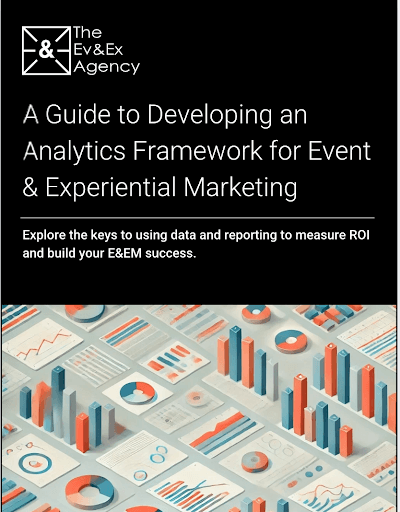Event marketers are under increasing pressure to prove results—not just attendance. Whether you’re planning immersive activations, industry trade shows, or internal summits, the success of your event shouldn’t rely on gut instinct or anecdotal feedback.
What you need is a bulletproof analytics framework, a systematic way to measure, report, and improve every event you run.
This article walks you through a seven-step approach to building a data-driven analytics framework tailored to event and experiential marketing (E&EM). Based on the Ev&Ex Analytics Framework Guide, these steps will help you align with business goals, deliver measurable ROI, and elevate your role from planner to strategist.
Step 1: Define What Success Looks Like
Before you gather a single data point, you need a clear picture of what you’re trying to achieve. This means translating high-level business goals into SMART objectives (Specific, Measurable, Achievable, Relevant, Time-bound) for your event.
Ask yourself:
- What outcomes matter to stakeholders?
- What behaviors or responses are we trying to influence?
- How will we know this event was a success?
Step 2: Identify Your Key Performance Indicators (KPIs)
Once you’ve defined your objectives, it’s time to determine which metrics will help you measure progress.
Your KPIs should reflect both quantitative and qualitative dimensions of performance. For instance:
- Engagement: Booth visits, dwell time, poll participation
- Reach: Social impressions, hashtag usage
- Satisfaction: NPS scores, post-event surveys
- Conversion: Lead form completions, app downloads, demo signups
Step 3: Choose Your Data Collection Methods and Tools
Not all event data is created equal. You need tools and methodologies that capture reliable, consistent, and relevant data across the attendee journey.
Some common methods include:
- Surveys and polls
- Digital tracking and analytics platforms
- RFID or beacon technology
- Social listening tools
Step 4: Analyze and Interpret the Data
Collecting data isn’t the end goal—understanding what the data means is. Schedule dedicated time post-event (and at key intervals afterward) to analyze your results.
Use methods like SWOT analysis, benchmarking, and sentiment analysis to develop real insight.
Step 5: Create a Reporting Framework
Build reporting systems that offer dashboards, executive summaries, and narrative insights. This is where you build credibility—by turning data into decisions. Decisions that are highly informed and effective.
Step 6: Leverage Insights to Optimize Future Events
Use insights to modify event formats, shift targeting, or reallocate budget to higher-performing strategies. There’s always room for improvement, so dig for the insights that empower it.
Step 7: Train Your Team and Normalize the Process
Your framework won’t work without people. Embed analytics into workflows, offer training, and foster a culture of measurement.
Putting It All Together
You’re building not just a set of processes, but a culture of accountability and improvement. When implemented, this framework will ensure every event is smarter than the last.


